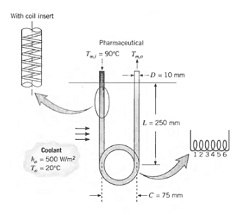Discuss the below:
Q: A bayonet cooler is used to reduce the temperature of a pharmaceutical fluid. The pharmaceutical fluid flows through the cooler, which is fabricated of 10-mm-diameter, thin-walled tubing with two 250-mm-Iong straight sections and a coil with six and a half turns and a coil diameter of 75 mm. A coolant flows outside the cooler, with a convection coefficient at the outside surface of ho = 500 W/m2 · K and a coolant temperature of 20°e. Consider the situation where the pharmaceutical fluid enters at 90°C with a mass flow rate of 0.005 kg/s. The pharmaceutical has the following properties: p = 1200 kg/m3, µ = 4 X 10-3 N · s/m2, c p = 2000 J/kg · K and k = 0.5 W/m · K.
(a) Determine the outlet temperature of the pharmaceutical fluid.
(b) It is desired to further reduce the outlet temperature of the pharmaceutical. However because the cooling process is just one part of an intricate processing operation, flow rates cannot be changed. A young engineer suggests that the outlet temperature might be reduced by inserting stainless steel coiled springs into the straight sections of the cooler with the notion that the springs will disturb the flow adjacent to the inner tube wall and, in turn, increase the heat transfer coefficient at the inner tube wall. A senior engineer asserts that insertion of the springs should double the heat transfer coefficient at the straight inner tube walls. Determine the outlet temperature of the pharmaceutical fluid with the springs inserted into the tubes, assuming the senior engineer is correct in his assertion.
(c) Would you expect the outlet temperature of the pharmaceutical to depend on whether the spring has a left-hand or right-hand spiral? Why?
